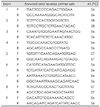1. Wallace RH, Marini C, Petrou S, Harkin LA, Bowser DN, Panchal RG, et al. Mutant GABAA receptor gamma2-subunit in childhood absence epilepsy and febrile seizures. Nat Genet. 2001. 28:49–52.

2. Marini C, Harkin LA, Wallace RH, Mulley JC, Scheffer IE, Berkovic SF. Childhood absence epilepsy and febrile seizures: a family with a GABAA receptor mutation. Brain. 2003. 126:230–240.

3. Kananura C, Haug K, Sander T, Runge U, Gu W, Hallmann K, et al. A splice-site mutation in GABRG2 associated with childhood absence epilepsy and febrile convulsions. Arch Neurol. 2002. 59:1137–1141.

4. Lu J, Chen Y, Zhang Y, Pan H, Wu H, Xu K, et al. Mutation screen of the GABAA receptor gamma 2 subunit gene in Chinese patients with childhood absence epilepsy. Neurosci Lett. 2002. 332:75–78.

5. Robinson R, Taske N, Sander T, Heils A, Whitehouse W, Goutières F, et al. Linkage analysis between childhood absence epilepsy and genes encoding GABAA and GABAB receptors, voltage-dependent calcium channels, and the ECA1 region on chromosome 8q. Epilepsy Res. 2002. 48:169–179.

6. Lu J, Chen Y, Pan H, Zhang Y, Wu H, Xu K, et al. The gene encoding GABBR1 is not associated with childhood absence epilepsy in the Chinese Han population. Neurosci Lett. 2003. 343:151–154.

7. Lu J, Pan H, Chen Y, Zhang Y, Liu X, Jiang Y, et al. Mutation screen of the gene encoding GABRB3 in Chinese patients with childhood absence epilepsy. Am J Med Genet A. 2003. 123A:197–200.
8. Kang JQ, Macdonald RL. The GABA
A receptor gamma2 subunit R43Q mutation linked to childhood absence epilepsy and febrile seizures causes retention of α1β2γ2S receptors in the endoplasmic reticulum. J Neurosci. 2004. 24:8672–8677.

9. Urak L, Feucht M, Fathi N, Hornik K, Fuchs K. A GABRB3 promoter haplotype associated with childhood absence epilepsy impairs transcriptional activity. Hum Mol Genet. 2006. 15:2533–2541.

10. Chen Y, Lu J, Zhang Y, Pan H, Wu H, Xu K, et al. T-type calcium channel gene alpha (1G) is not associated with childhood absence epilepsy in the Chinese Han population. Neurosci Lett. 2003. 341:29–32.

11. Vitko I, Chen Y, Arias JM, Shen Y, Wu XR, Perez-Reyes E. Functional characterization and neuronal modeling of the effects of childhood absence epilepsy variants of CACNA1H, a T-type calcium channel. J Neurosci. 2005. 25:4844–4855.

12. Wang J, Zhang Y, Liang J, Pan H, Wu H, Xu K, et al. CACNA1I is not associated with childhood absence epilepsy in the Chinese Han population. Pediatr Neurol. 2006. 35:187–190.

13. Everett KV, Chioza B, Aicardi J, Aschauer H, Brouwer O, Callenbach P, et al. Linkage and association analysis of CACNG3 in childhood absence epilepsy. Eur J Hum Genet. 2007. 15:463–472.

14. Liang J, Zhang Y, Chen Y, Wang J, Pan H, Wu H, et al. Common polymorphisms in the CACNA1H gene associated with childhood absence epilepsy in Chinese Han population. Ann Hum Genet. 2007. 71:325–335.

15. Kananura C, Sander T, Rajan S, Preisig-Müller R, Grzeschik KH, Daut J, et al. Tandem pore domain K(+)-channel TASK-3 (KCNK9) and idiopathic absence epilepsies. Am J Med Genet. 2002. 114:227–229.

16. Holter J, Carter D, Leresche N, Crunelli V, Vincent P. A TASK3 channel (KCNK9) mutation in a genetic model of absence epilepsy. J Mol Neurosci. 2005. 25:37–51.
17. Bowser DN, Wagner DA, Czajkowski C, Cromer BA, Parker MW, Wallace RH, et al. Altered kinetics and benzodiazepine sensitivity of a GABAA receptor subunit mutation [gamma 2(R43Q)] found in human epilepsy. Proc Natl Acad Sci U S A. 2002. 99:15170–15175.

18. Baulac S, Huberfeld G, Gourfinkel-An I, Mitropoulou G, Beranger A, Prud'homme JF, et al. First genetic evidence of GABA
A receptor dysfunction in epilepsy: a mutation in the gamma2-subunit gene. Nat Genet. 2001. 28:46–48.

19. Harkin LA, Bowser DN, Dibbens LM, Singh R, Phillips F, Wallace RH, et al. Truncation of the GABA
A-receptor gamma2 subunit in a family with generalized epilepsy with febrile seizures plus. Am J Hum Genet. 2002. 70:530–536.

20. Proposal for revised classification of epilepsies and epileptic syndromes. Commission on Classification and Terminology of the International League Against Epilepsy. Epilepsia. 1989. 30:389–399.
21. Meldrum BS, Rogawski MA. Molecular targets for antiepileptic drug development. Neurotherapeutics. 2007. 4:18–61.

22. Macdonald RL, Kang JQ, Gallagher MJ. Mutations in GABAA receptor subunits associated with genetic epilepsies. J Physiol. 2010. 588:1861–1869.
23. Macdonald RL, Gallagher MJ, Feng HJ, Kang J. GABAA receptor epilepsy mutations. Biochem Pharmacol. 2004. 68:1497–1506.

24. Tan HO, Reid CA, Single FN, Davies PJ, Chiu C, Murphy S, et al. Reduced cortical inhibition in a mouse model of familial childhood absence epilepsy. Proc Natl Acad Sci U S A. 2007. 104:17536–17541.

25. Chiu C, Reid CA, Tan HO, Davies PJ, Single FN, Koukoulas I, et al. Developmental impact of a familial GABAA receptor epilepsy mutation. Ann Neurol. 2008. 64:284–293.




 PDF
PDF ePub
ePub Citation
Citation Print
Print




 XML Download
XML Download